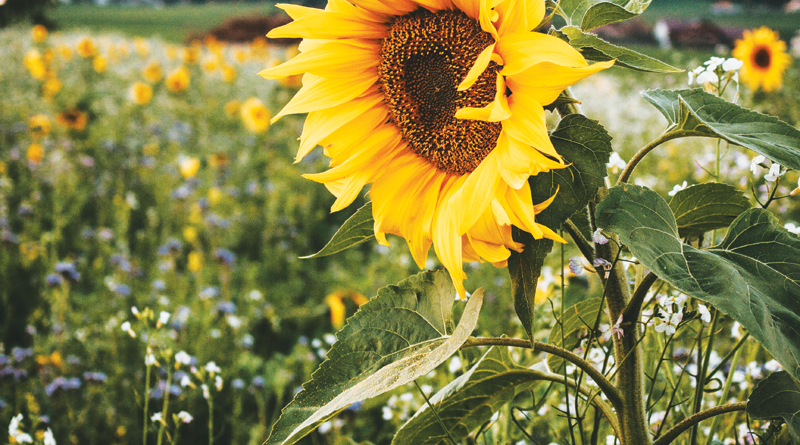SUNFLOWERS FOR FOOD OR BEAUTY? – Green-Thumb Gardener

The common sunflower (Helianthus annuus) originated in the Americas in 1000BC and was cultivated for food. These flowers are sought by consumers for their bright, cheery looks both in gardens and cut-flower arrangements.
The common sunflower is an annual member of the aster family and does not survive the winter in our area. Occasionally, they drop seed that might grow the following season. There are approximately 70 varieties in three main categories of tall sunflowers, dwarf (3 foot or smaller), and colored. They are a composite type flower which means they have multiple flowers and types of flowers. The rays around the outer edge are the ones with the yellow petals and they do not produce seed. The individual disc flowers each reproduce to form a seed.
When planting sunflowers, generally you need to wait until after the average frost free date, but be sure your soil has warmed and is not soggy before doing that. The plants need a minimum of 6 hours of sun and are heavy water users. Be careful that your patch does not become weedy as the weeds use up much of the moisture they require. They can be planted in containers as well, but be careful to check for their water needs frequently as pots dry out quickly.
Sunflowers are grown in agriculture for their edible seeds used both for humans, birds, and livestock. They are frequently grown for the oil that is extracted from the seed which is again edible and sometimes used in industrial applications. The Dakotas and Minnesota are the state with the most sunflower production.
As the fall season gets longer, pollinators are looking for nectar. Perennial sunflowers can provide this from late summer through frost. The perennials in the Helianthus genus are generally bushy plants with multiple heads, many of which are great bloomers for your late summer landscape.
The false sunflower group (Heliopsis helianthoides) have similar flowers with a cone-shaped central disc rather than flat. They are generally 3 to 6 feet tall and have a longer bloom period for much of the summer.
When you need a mood-booster, sunflowers can certainly fill that need. Try them in your gardens and containers and grow enough for some extra cut-flower bouquets to take inside. The spent heads of your sunflowers will provide treats for the birds throughout the fall and into winter. Talk to the good folks at your local garden center to help you find many great options!
This article is sponsored by McNamara at Sand Point, which has 2 acres of production greenhouses, retail florist and gift shop, as well as retail garden center and wholesale plant business. Contact McNamara by calling 260-747-4131 or visit 4322 DeForest Ave, Ft. Wayne, IN 46809.
- Celebrating 20 Years Of Community At The Stand - April 12, 2024
- First Positive Case Of Chronic Wasting Disease In Indiana - April 12, 2024
- Southwest Allen County Schools Embark On Major Tree Plantings - April 12, 2024


